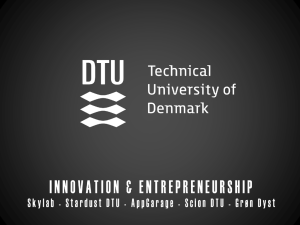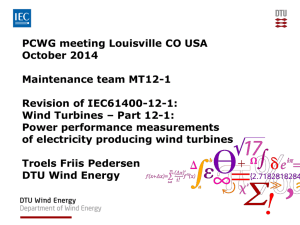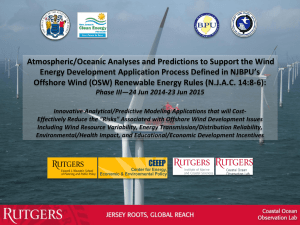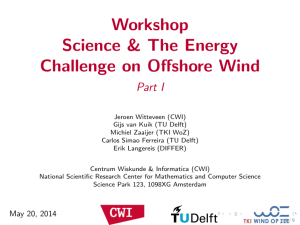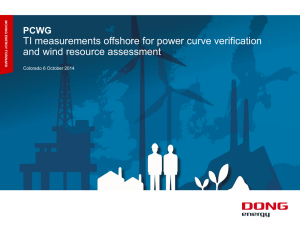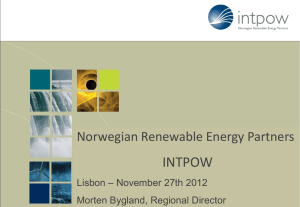Research overview from Risø
advertisement
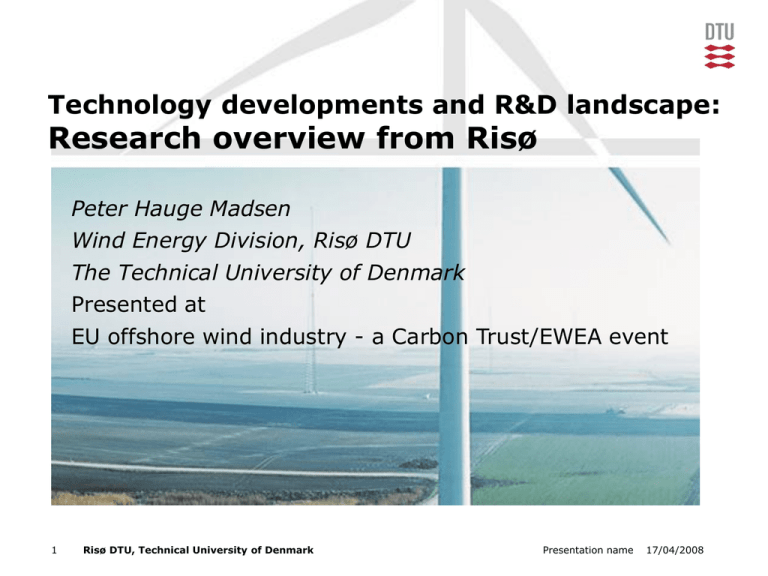
Technology developments and R&D landscape: Research overview from Risø Peter Hauge Madsen Wind Energy Division, Risø DTU The Technical University of Denmark Presented at EU offshore wind industry - a Carbon Trust/EWEA event 1 Risø DTU, Technical University of Denmark Presentation name 17/04/2008 Wind Energy Division - Risø DTU Technical University of Denmark • Windpower Meteorology • Aeroelastic design methods • Wind Turbine Structures • Offshore Wind Energy • Remote sensing & Measurements WIND ENERGY DIVISION INTERNATIONAL CONSULTING Meteorology 2 Aeroelastic Design Risø DTU, Technical University of Denmark • Windpower control & integration EDUCATION Wind Turbines • Certification Scheme Wind Energy Systems Test & Measurement Presentation name 17/04/2008 ”Wind Energy Roadmap” in the EC Communication of Financing Low Carbon Technologies. TPWind priorities 20102012: • Development and testing of new structures • Automation (industrywide study) • Technology transfer from oil & Gas 3 Risø DTU, Technical University of Denmark Presentation name 17/04/2008 Research, development and demonstration challenges – Danish MEGAVIND strategy 4 Target to make offshore wind power competitive with conventional coalfired power by 2020 (50 % reduction in cost). Risø DTU, Technical University of Denmark Presentation name 17/04/2008 EERA JP on Wind Energy 5 Risø DTU, Technical University of Denmark Presentation name 17/04/2008 EERA JP on Wind Energy 6 Risø DTU, Technical University of Denmark Presentation name 17/04/2008 EERA JPWE EERA JP on Wind Energy 7 Risø DTU, Technical University of Denmark Presentation name 17/04/2008 Wind Energy Division - Risø DTU Technical University of Denmark DTU BYG WIND ENERGY DIVISION DTU IMM DTU MEK INTERNATIONAL CONSULTING EDUCATION Offshore Wind Energy Meteorology Aeroelastic Wind Wind Energy Design 8 Risø DTU, Technical University of Denmark Turbines Systems Test & Measurement Presentation name 17/04/2008 Risø DTU – Offshore Wind Energy R&D priorities • Marine wind, wave and current conditions – Characterize the geophysical processes,estimate local conditions and develop design basis • Wakes in offshore wind turbine farms – Characterize and model wakes (performance and loads) in relation to interaction between turbines, between farms and large scale climate effects • Installation and maintenance – Methods, models and tools to support installation and maintenance incl. Wind wave prediction, remedial and preventive maintenance and condition monitoring • Integrated design tools – Integrated aero-hydro-servo-elastic tools incl. wave loads,soil-structure and fluid-structure interaction 800 700 Power (MW) 600 • Offshore wind integration 500 HRB HRA HR2 HR1 400 300 200 – Models and tools for design and control of offshore grid and clusters 100 0 28/1-2000 29/1-2000 30/1-2000 31/1-2000 1/2-2000 Time • New concepts 9 Risø DTU, Technical University of Denmark Presentation name 17/04/2008 Offshore Wind Conditions Lidar wind data and model from Horn’s Reef offshore Satellite winds showing the wake at Horn Reef wind farm. Mean wind speed map using satellite Envisat ASAR. 10 Risø DTU, Technical University of Denmark • Ocean winds • Lidar observations and modelling • Wind resource mapping using satellite data • Mesoscale modelling • Meteorological mast observations • Wind farms shadow effect • Satellite observations Presentation name 17/04/2008 Horns Rev offshore site Courtesy: DONG Energy and Alfredo Peña, Risø DTU 11 Risø DTU, Technical University of Denmark Presentation name 17/04/2008 Wind loads dominated by wake effects CFD – Large eddy simulation 12 Risø DTU, Technical University of Denmark Presentation name 17/04/2008 Fuga – a new, linearized wake model • Solves linearised RANS equations • Closure: mixing length, k-e or ’simple’ (nt=ku*z) • Fast, mixed-spectral solver using pre-calculated look-up tables (LUTs) • No computational grid, no numerical diffusion, no spurious mean pressure gradients • Integration with WAsP: import of wind climate and turbine data. • 105 times faster than conventional CFD! 13 Risø DTU, Technical University of Denmark Presentation name 17/04/2008 User friendly GUI 14 Risø DTU, Technical University of Denmark Presentation name 17/04/2008 Validation: Horns Rev I. 1.00 270+-7.5 270+-12.5 Fuga 0.90 Normalized prod. Fuga 270+-17.5 Fuga 270+-7.5 0.80 Data 270+-12.5 Data 270+-17.5 Data 0.70 0.60 0.50 0.40 1 2 3 4 5 6 7 8 9 10 Row number Simple closure: nt=ku*z No adjustable parameters! 15 Risø DTU, Technical University of Denmark Presentation name 17/04/2008 Validation: Nysted. 1.10 273+-7.5 Fuga 273+-12.5 Fuga 273+-17.5 Fuga 273+-7.5 Data 273+-12.5 Data 273+-17.5 Data Normalized production 1.00 0.90 0.80 0.70 0.60 0.50 0.40 1 2 3 4 5 6 7 8 Row number Simple closure: nt=ku*z 16 Risø DTU, Technical University of Denmark Presentation name 17/04/2008 Downwind Speed Recovery • FUGA - predicts a much ”slower” speed recovery than standard wake models. • For HR rec.distance is about 16 km; somewhat slower than observed 4) Normalized wind speed through the wind farm and behind the wind farm compared to measurements at Horns rev. Full curves are canopy-CFD-model predictions. _______________________________________________________________________________________ 4) R.J.Barthelmie et al., ” Flow and wakes in large wind farms: Final report for UpWind WP8”. Risø-R1765(EN) (2011). 17 Risø DTU, Technical University of Denmark Presentation name 17/04/2008 Design of offshore wind turbines – Offshore wind turbines are not onshore wind turbines! • hydrodynamic loads, sea ice, long periods at standby – Offshore wind turbines are not oil rigs! • wind loads, shallow water, dynamics, unmanned – Marriage of expertise from wind power and offshore engineering industries – Technology Risks • Improve confidence with which offshore wind farms can be financed and implemented rotor-nacelle assembly tower tower support structure platform water level sub-structure sub-structure pile sea floor pile seabed foundation 18 Risø DTU, Technical University of Denmark Presentation name 17/04/2008 Standards for Offshore Wind Turbines •Onshore wind turbines – IEC 61400-1, Edition 3 •Offshore wind turbines – – – – IEC 61400-3 GL Regulations for Offshore WECS, 1995 DNV, Design of Offshore Wind Turbine Structures, OS-J101, 2007 GL Wind, Guideline for the Certification of Offshore Wind Turbines, 2005 •Offshore structures – petroleum and natural gas industries – – – – 19 ISO ISO ISO ISO 19900, 19901, 19902, 19903, General Requirements for Offshore Structures, 2002 Specific Requirements for Offshore Structures, 2003 Fixed Steel Offshore Structures, 2004 (DIS) Fixed Concrete Offshore Structures, 2004 (DIS) Risø DTU, Technical University of Denmark Presentation name 17/04/2008 Walney Offshore Wind Farm Project Partners: Risø DTU, DONG, Siemens 1. Large offshore wind farm being constructed by DONG energy with ~50 machines in phase 1 2. Siemens 3.6MW machines with monopile foundations 3. Average HH wind speed: 9.3 m/sec 4. Water depth 19m –28 m Objectives 1. Database of loads measurements with correlated wind and wave data 2. Assessment of uncertainty in loads simulations to provide improved structural reliability. 3. Recommendations to international wind turbine standards on offshore turbine design. 20 Risø DTU, Technical University of Denmark Presentation name 17/04/2008 EUDP Walney Offshore Wind Farm Project Measurements: • Nacelle mounted LIDAR measuring wind speed at 2.5 rotor diameter in front of turbine. • Wave and current measurements near foundation 21 Risø DTU, Technical University of Denmark Presentation name 17/04/2008 Benefits from the project and its need 1. Maturity of loads prediction on offshore wind turbines, both on the support structure, as well as rotor nacelle. • • • Provides offshore turbine loads data for research purposes. Provides for correlated wind and wave measurements for each load data point. One of the very few nacelle mounted LIDARs for offshore wind turbines with accurate wind measurements 2. Cost effective foundations. – – Improved accuracy for site specific loads prediction Estimation of damping of the structure to mitigate fatigue and extreme loads 3. Long term loads on the foundations – – 22 Fatigue and ultimate strength requirement evaluations Enables improved life prediction Risø DTU, Technical University of Denmark Presentation name 17/04/2008 DEEPWIND – New EU Funded Program Vertical axis wind turbine Bottom mounted generator for weight savings 23 Risø DTU, Technical University of Denmark Presentation name 17/04/2008 Combined floating wind- and wave energy converter – Poseidon Experiment PSO project, measurements and modeling: DONG, FPP, DHI and Risø DTU 3x GAIA 11kW. Downwind, Free yaw and teetering Grid connection point Wave energy conversion device Mooring point 24 Risø DTU, Technical University of Denmark Presentation name 17/04/2008 Poseidon: Modeling Challenges • Three rotors in one simulation – Structural modeling already possible in the multi-body formulation – Aerodynamic model updated to handle this • Wake from upwind rotors – Already possible with the dynamic wake meandering model in HAWC2 • Large water surface area • Full coupled HAWC2-WAMSIM simulations • HAWC2 validated aeroelastic code • WAMSIM validated radiation/diffraction code for dynamic of floating structures from DHI • WAMSIM recode to HAWC2 dll-interface format • Ordinary HAWC2 turbine model • Ordinary WAMSIM model • Full system solved by HAWC2 Risø Hawc2 Overview 25 Risø DTU, Technical University of Denmark Presentation name 17/04/2008 Conclusions • The development of offshore wind energy depends not only on industrial development and demonstration –but also on medium to long term research • Site conditions very complex – the site specific design conditions are derived in an ad-hoc and pragmatic way • Integrated design tools exist but are primarily used to demonstrate conservatism of approach • Limited validation of design loads and response • Deep water (> 30 m) is a challenge • Deep water concepts under way • Offshore wind is just at the beginning – all options are open 26 Risø DTU, Technical University of Denmark Presentation name 17/04/2008 Thank you for your attention 27 Risø DTU, Technical University of Denmark Presentation name 17/04/2008
